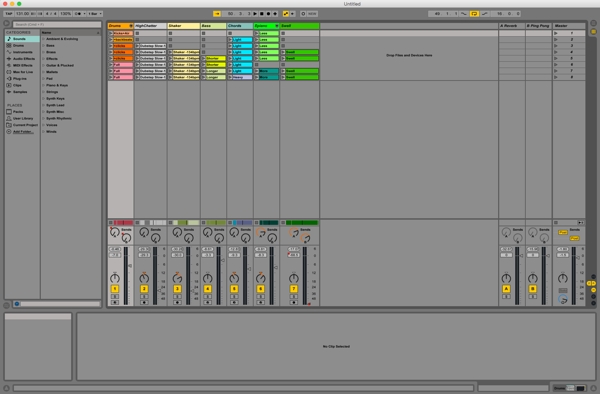Stuck in the tango. No sign of improvement. We are at 6 on the Lyles Scale of Compositional Agony, with no relief in sight.
So instead of actually working on it, I have downloaded the trial version of Ableton Live, a piece of music software that I have been assured by several people will be the tool I need to create an orchestral performance track for Christmas Carol.
It has been more than 15 years since I had to tinker with such software, and back then—pre-Mac OS X days, even—the software I used was simple and straightforward. But in the intervening years, the consumer end of such things has dropped off and the pros have taken over. If you don’t know what I mean, look at the following screenshots from Live:

No, really, click on it.
Oy.
It has two “views,” Arrangement and Session. At this point—I just installed the thing—I don’t even know which one is which. Here’s the other one:

Oy, also too. ::sigh::
Cover me, I’m going in. Updates as I surface.
10:10 am: I may have a clue. In the second image above—that’s the Session view—each of the little colored boxes is a loop of some kind, either a beatbox or riff or some other kids-these-days item. The columns are all using the same instrument to create the clips. The rows are called “scenes,” and that’s where you combine/recombine all your whomp-whomp bits. (That’s a technical term.)
So, for my purposes… We’ll use “Marley’s Departure” as our test case. Here’s a score so you can follow along at home. We have one measure of nervous diddling about, then two measures that repeat while the cast plays a scene about Scrooge seeing a ton of spirits like Marley hovering about the London streets, and then a final measure that we jump to when we reach the cue “…and lost the power forever!”
Here’s what I think will work: I go in, export each section as a clip. Then I’ll have three scenes in Live, each one with one clip. Hm… now I’m hazy. Will someone have to “play” the piece live, i.e., click on scenes 1-2-3 in order (they loop until you click on the next one)—or can I line them up in the Arrangement view, loop the second one, then whoever’s in charge of the computer clicks some kind of NEXT button to skip to the third one?
Step one is to export those three audio clips from Finale. Back in a moment.
11:00 am: Problems:
- Each clip seems to have two seconds of silence at the end. I think that’s a Finale export preference thing and should be easily fixable.
- I figured out how to add the folder of exported .aiff files to the “browser” of Live—although you can drag-and-drop directly from the Finder, but when I drag them into the Arrangement timeline, there is no sound.
- Clicking on each clip in the browser previews the clip, i.e., plays it, but again, dragging it to the timeline produces no sound.
- If I drag a clip in Session view, I can click the Solo button and there is sound, but it’s muddy and clicky—which is not the case if I preview it in the browser.
- The User Manual is of no assistance in this issue.